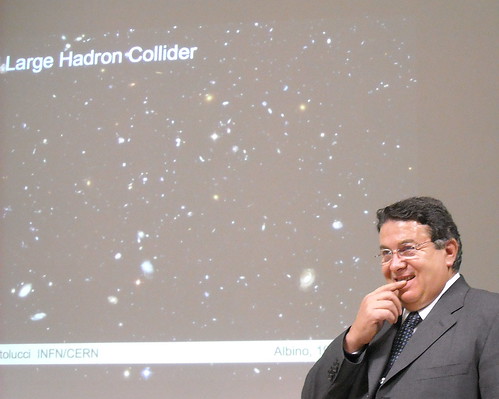SIT still a moment. I’m taking it upon myself here to explain to you what the Higgs boson is and what its discovery means to humankind. No, no, stay. Where are you going? Come back.
Just joking. I wouldn’t dream of explaining it. You’re more than likely every bit as capable of pretending to understand it as I am. And if not, fear not: everything you need to know is contained in this joke, via comedian Dara Ó Briain. A Higgs boson walks into a church. The priest says, “What are you doing here?” and the Higgs boson says, “You can’t have mass without me”.
So they’ve discovered the hypothetical particle that gives mass to other elementary particles. Or they’re fairly sure they have. More study is needed. Consider the following sentence: “Physicists at Cern have observed evidence of a new particle consistent with the Higgs boson.” You see the problem with that, don’t you? Isn’t it a little dry? Well here’s another one instead: “Scientists discover God particle!” There, that’s better.
This, in essence, represents the problem that physics is up against. Hardly anybody understands it, and things happen in it at a glacial pace. Not even archaeologists have to be as patient as physicists. Worst of all, it’s invisible, and so can’t be televised or shared on Flickr. This makes physics incompatible with life in the 21st century.
All the same, there’s a lot of money going into it, and seriously important questions inspiring it, so those with an interest in physics do their best to make it seem sexy – with mixed results, as we’ve seen.
No sooner had the findings been announced this week than there was a massive nerdish backlash against Cern, because their slides were in Comic Sans, the world’s most-ridiculed font.
Now it could be that the people at Cern don’t know the first thing about typography (in which case, ha ha, they must be so stupid).
But it’s more likely to have been an attempt on the scientists’ part to make the results more accessible. They may have reasoned that a sentence such as, “We present updated results on SM Higgs searches based on the data recorded in 2011 at √s=7 TeV (~4.9 fb-2) and 2012 at √s=8 TeV (~5.9 fb-2)” would become intelligible even to thick people if it were made to look like a clipping from the Beano.
“Oh great,” said everyone, when news of the discovery ‘leaked’. “How thrilling. And how nice for Mr Higgs.” There then followed predictable skirmishes between believers and atheists. One side believes in a theoretical, invisible energy field that pervades the whole cosmos, even though they have not seen proof of it with their own eyes; the other side believes in God.
Then people quickly began to move on. It’s 2012, our attention spans are short, what did you expect? “What happens next?” said everyone. It turns out the Large Hadron Collider will be out of commission for the whole of next year. “Oh, so nothing happens next? Really? OK, well, look, come back when you can give us time travel or something useful.”
This isn’t the first time Cern has unintentionally disappointed us either. Remember back in September 2008, when they fired the first protons through the Large Hadron Collider? The world waited, breathless with excitement, listening to live simulcasts and what have you. Then the results appeared, in the form of two tiny white dots on a computer screen. All the physicists cried tears of happiness. Everyone else looked blankly at each other and said, “Wait a second. Is that it?”
To be fair, though, the people at Cern were the soul of restraint in their comments about the significance of their discovery this week. It was the media – the mass media (forgive me, that pun would not be denied) – that became hysterical.
“It was without doubt a splitting-the-atom, DNA-double-helix, penicillin-discovering moment, a once-in-a-generation breakthrough,” panted the Irish Times. ‘Eureka!,’ bellowed the Washington Post, while also grumbling that the discovery should have happened in America. ‘Everything In Universe Now Explained,’ shrieked countless headlines, more or less.
Contrast this with the passionless official statement from Cern. “The observation of this new particle indicates the path for the future towards a more detailed understanding of what we’re seeing in the data,” said Cern research director Sergio Bertolucci. Similarly, director general Rolf Heuer remarked: “The discovery of a particle consistent with the Higgs boson opens the way to more detailed studies”.
That was Cern’s people in celebratory mood. And to anyone who has ever answered the ‘name your ideal dinner guest’ question with ‘particle physicist’, I say, let that be a warning to you. Imagine the office parties at Cern… Well, at least, if nothing else, they have an abundance of helium for the balloons.
Published in the Irish Mail on Sunday 8 July 2012
